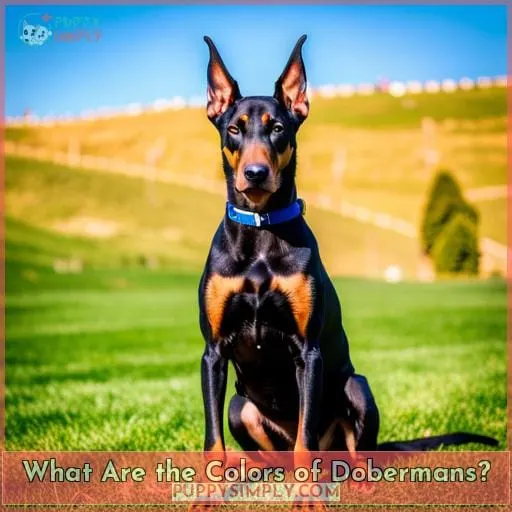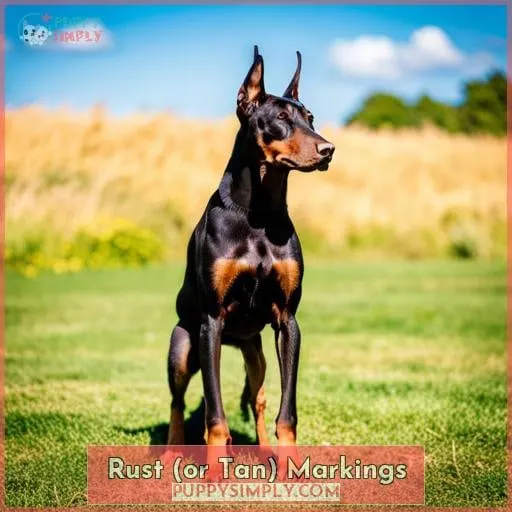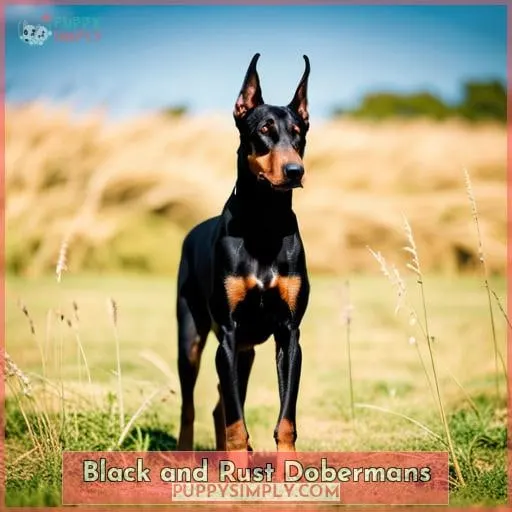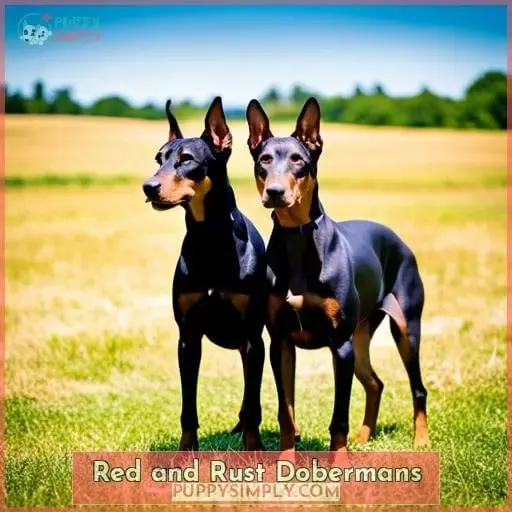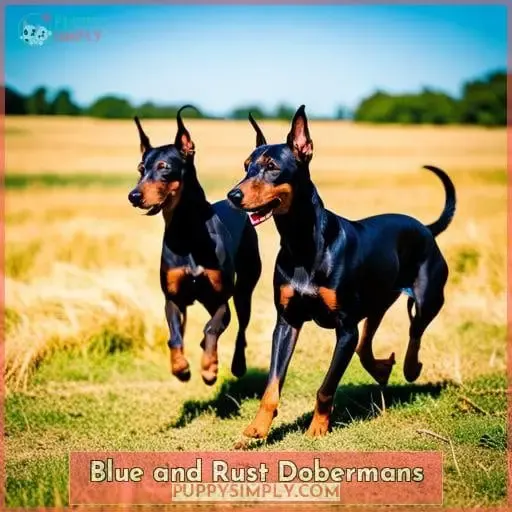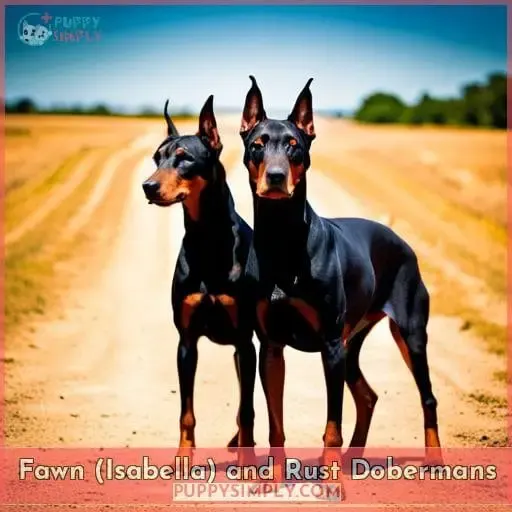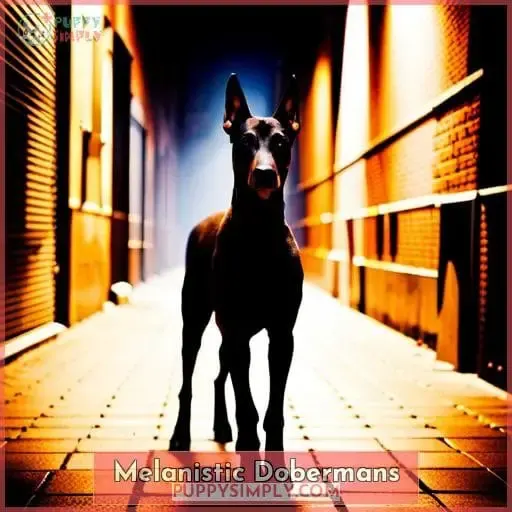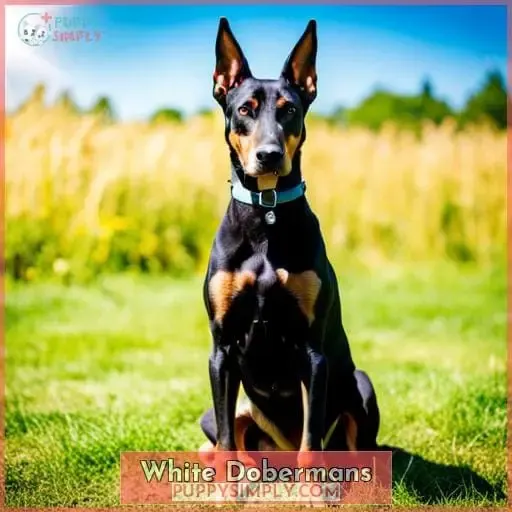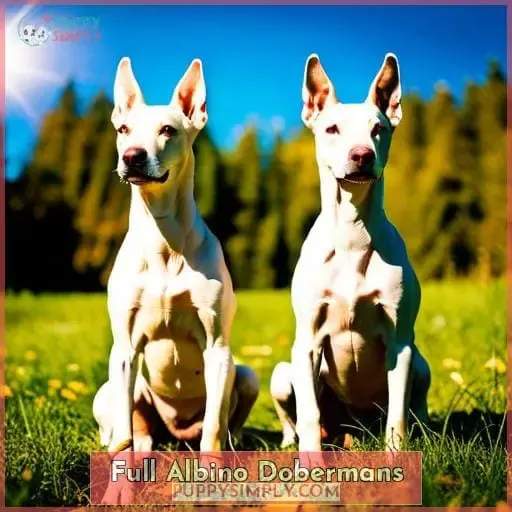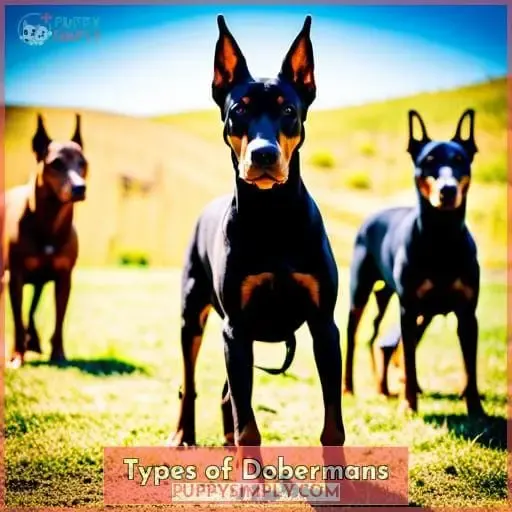This site is supported by our readers. We may earn a commission, at no cost to you, if you purchase through links.
Are you looking to bring a new Doberman Pinscher pup into your home? Known for being powerful and loyal, these dogs come in various colors that can help make them stand out from the pack.
Not only that, but melanistic variants of each color are also available with black-colored fur as well as red-colored fur. White Dobes exist too, as well as full albino varieties; though this is quite rare.
This article will give an overview of all the different types of colors you’ll find in a typical litter so let’s dive right in!
Table Of Contents
Key Takeaways

- Dobermans come in various colors, including black and tan, blue, fawn, red, and white.
- The most common color for Dobermans is black and tan.
- Different temperaments have been observed between lighter and darker-colored Dobermans.
- White Dobermans are rare and have a striking coat and gentle demeanor.
What Are the Colors of Dobermans?
You can stay warm and stylish with this best-selling sweater, available in a variety of vibrant hues to match your pup’s perfect coat! Dobermans come in various colors, including the full albino European Doberman.
The most common color for these dogs is black and tan, but they also come in blue, fawn, or red. The blue color comes from a recessive gene known as the ‘color dilution gene,’ which affects the production of melanin pigment resulting in either grayish or bluish fur.
To ensure you are getting an authentic colored Dobie puppy, it is important to verify that both parents have not been affected by any genetic diseases associated with their coloring, such as Albinism (lack of pigmentation) or CCD (Color Coat Dilution).
In addition to verifying your pup’s pedigree papers, it may be helpful if you can visit them before bringing them home so that you know exactly what type of coloring they will have when fully grown up.
It is important for anyone looking into adding a new furry family member into their lives to understand how much exercise requirements, grooming needs, socialization tips, and health care maintenance goes along with owning one of these amazing creatures.
Whether it’s an old faithful companion who has been around through thick and thin over many years or just starting out on this grand adventure, make sure whatever decision made about breed type includes having some understanding about Doberman colors.
Rust (or Tan) Markings
The rust, or tan markings on Dobermans are often a combination of light and dark colors, adding an attractive contrast to any pup’s coat. In American Dobermans, the most common color is black and tan, but they also come in blue, fawn-colored, or red.
The color genetics associated with these rust markings can be complex. However, understanding what causes them will help you make sure your pup stays healthy throughout their life.
Knowing how to groom for specific coloring requirements is essential, as well as keeping an eye out for any health risks that may arise due to genetic deficiencies linked with certain coats.
Different temperaments have been observed between Dobies depending on their coat color. Lighter-colored puppies tend to be more docile, while darker dogs are usually more fearless adventurers! It’s important when choosing a puppy that you understand the differences between each shade so you can find one that fits best into your lifestyle and home environment.
With proper knowledge about these distinctive features associated with Doberman Pinschers, it will enable owners to make better decisions regarding selecting a companion animal for years of enjoyment together!
Black and Rust Dobermans
Black and Rust Dobermans are a stunning combination of two colors that stand out in the canine world. The AKC’s Doberman Pinscher information page explains that they have black coats with rust-colored markings on their face, chest, legs, and underparts.
To achieve this beautiful color combo, breeders must carefully combine genes from both pure-colored dogs as well as those that carry the recessive red gene.
Black is dominant over all other colors, while tan or rust is produced when a dog carries two copies of this gene variant – one from each parent.
Typical traits for these pups include an alert nature with high intelligence levels – making them excellent guard dogs if trained properly! Additionally, black and rust Dobermans often possess strong endurance qualities, allowing them to excel in physical activities like running or agility courses, given their athletic build and natural athleticism.
However, due diligence should be taken by owners when exercising any breed during hot days so proper hydration can be maintained throughout activity sessions.
Owners will also need to consider grooming needs specific to this coat type since regular brushing will help keep fur healthy without matting issues arising later down the line!
Overall, though, Black & Rust Dobermans make wonderful companion animals who bring joy into households with their vibrant personalities.
Red and Rust Dobermans
Explore a unique color combination and add some pizzazz to your pup with Red and Rust Dobermans! Red and rust is one of the most beautiful color variations available in the breed, which can be achieved when two dogs carrying this recessive gene variant are bred together.
The AKC’s Doberman Pinscher information page explains that these pups have black coats with tan markings on their face, chest, legs, underparts, as well as white patches mixed into the main coat color.
Within each litter, there may also be varying shades of red or rust, making for an array of stunning combinations.
The traits associated with this striking look include intelligence levels that make them excellent guard dogs. If trained properly, they will alert you to any potential threats without hesitation! In addition to being highly intuitive watchdogs, they often possess strong endurance qualities, enabling them to take part in physical activities such as agility courses – thanks largely due to their athletic build coupled with natural athleticism (though owners should ensure proper hydration during hot days).
With regards to grooming needs specific to this coat type, it’s important for owners to regularly brush Red & Rust Dobermans’ fur so that matting issues don’t arise later down the line.
Overall, it’s a great choice for those looking for intelligent, loyal companions who come ready equipped not only with looks but amazing character too – no wonder why many fall head over heels in love at first sight when presented with these magnificent creatures decked out in all their full glory, wearing their signature colors: black covered partially with tan marks plus white patching throughout their main coat… simply breathtaking!
Blue and Rust Dobermans
You’ll be amazed by the majestic beauty of Blue and Rust Dobermans, with their striking coats featuring tan markings on the face, chest, legs, and underbelly, plus white patches mixed in. These beautiful pups are a result of two dogs carrying a recessive gene variant being bred together.
As per breed standards set forth by The American Kennel Club (AKC), they should have black fur with these additional colors throughout.
Owners who take proper care of their Blue & Rust Doberman will find that regular grooming is key to maintaining its stunning look – brushing its coat regularly helps prevent matting issues from arising later down the line.
Exercise needs should not be overlooked either – as deep-chested breeds like this one can sometimes suffer from skin conditions or alopecia if overworked in hot weathers; therefore making sure your pup gets ample rest during such times is highly encouraged too!
Blue & Rust Dobermans truly make wonderful companions for those looking for loyal yet intelligent furry friends – ones which offer an exquisite combination of looks coupled with outstanding character traits all within one package! Plus, some litters may even produce blue rust or fawn-rust colored puppies, adding further diversity amongst these amazing creatures: thus enabling more choices than ever before when searching out that perfect companion pet who’ll bring joy into your life every day ahead!
Fawn (Isabella) and Rust Dobermans
Discover the unique beauty of Fawn (Isabella) and Rust Dobermans, boasting a stunning combination of colors that will make heads turn! These gorgeous dogs are known for their intelligence, loyalty, and protective instincts.
They have a strong sense of family but may be wary around strangers if not socialized properly.
As far as health is concerned, these canines typically live up to 10-12 years with few major medical issues when given regular exercise and proper nutrition.
To ensure your pup remains in peak condition, it’s important they receive correct training at an early age. Basic commands like ‘sit’ or ‘stay’ should be taught alongside obedience classes so they understand how you expect them to behave outside home territory as well.
The history behind this majestic dog dates back centuries ago where it was utilized by farmers as guard dogs due to its strength and size. Hence, why many people still use them today when looking for protection from potential intruders without having to resort to violence themselves.
When seeking out such canine companionship, always remember to find reliable Doberman breeders approved by AKC before committing to anything further. This way, you can rest assured knowing you have done the right thing by your new four-legged friend during the search process itself – thereby guaranteeing lifelong happiness together later down the line too indeed.
Melanistic Dobermans
You’ve probably heard of the classic colors for Dobermans, such as Red and Fawn. But did you know that there are also rarer color varieties like Black, Blue, and Melanistic? These striking dogs have a unique look to them and can make great protectors or loyal companions, depending on your needs.
Black
Experience the striking beauty of Black Dobermans, a regal breed that will have you saying Once seen, never forgotten! These dogs are known for their impressive energy levels and loyalty. They may be prone to certain health risks such as thyroid problems or hip dysplasia, so it’s important to keep an eye on them.
Training challenges can also arise due to their strong-willed temperament, but with proper guidance, these pooches can learn quickly.
When considering this particular canine companion, remember that European and American types differ slightly regarding both temperament differences and the most common color combination options available today.
With good care, your new pup could bring years of joy into your home – making it an ideal choice for those who want protection without violence, plus plenty of unconditional love all at once!
Red
Feel the power of a Red Doberman’s presence as you behold their impressive stature and intense loyalty. Exercise is important for this breed to maintain health, so be prepared to provide plenty of playtime and walks.
Grooming requirements are minimal; brushing once or twice per week will suffice for most dogs.
Temperament-wise, these pups need an owner who can provide firm but fair leadership with consistent training tips in order to prevent them from becoming too stubborn! Health concerns such as hip dysplasia should also be monitored closely – particularly if your pup is one of the rare reds with a small white patch on its chest!
The European Dobermans have traditionally been bred in this color, while American Doberman Pinschers often come in black coats – making it all the more special when you see one out there that stands apart from other breeds by being unique yet still traditional at heart!
Blue
Unlock the mystery of a Blue Doberman’s majestic presence and immerse yourself in its loyal spirit – an embodiment of the saying ‘true blue friends are hard to find’.
Training is key for this breed, and firm but fair leadership with consistent reinforcement will help ensure it reaches its full potential.
Grooming needs include regular brushing as well as occasional nail clipping and ear cleaning.
Proper nutrition, exercise, care, and socialization also play essential roles in creating a successful bond between you and your pup!
German pinschers come at various price points depending on their coloration; however, white Doberman puppies may be more expensive due to mutations such as alopecia or pigment loss.
Regardless of whether you choose red or blue-eyed, embracing one of these noble canines into your home is sure to add years of joy!
Fawn
Admire the grace and beauty of a Fawn Doberman pup, whose majestic coat is sure to leave you in awe. Understanding this classic coloration requires learning about its possible colors, physical traits, health issues, and grooming requirements.
Training challenges may arise due to their temperamental differences compared to other Dobermans, but when done properly, it can lead them into dog shows with success! The official breed standard states that fawns must have lighter tan-colored markings on the muzzle/face area, as well as blackish-brown eyes – making this hue truly unique among canine companions.
With proper care and attention, these loyal guardians can make any home brighter!
White Dobermans
Discover the beauty of rare White Dobermans, with their striking coat and gentle demeanor – a unique and eye-catching addition to any home. Developed in Germany by canine geneticist Otto Goeller in the late 1800s, these elegant dogs are one of the most sought-after breeds today.
While many people assume that all Dobermans are black or brown, they can also be found sporting white coats – however, this is a relatively rare gene mutation known as ‘albinism’.
White Doberman genetics have been carefully studied over time by experts such as Goeller himself, who developed an extensive breeding program to promote healthy traits within this breed. This includes specific genes responsible for maintaining good health, including those related to overall appearance and temperament.
The resulting White Dobes often feature strong skeletal frames combined with plush fur, which can range from almost pure white through shades of cream or ivory, depending on individual genetics.
White Dobes typically share similar temperaments regardless of color; being loyal companions who form tight bonds with family members while remaining vigilant protectors when necessary – making them great pets for active households looking for canine guards! However, it’s important to note that some European bloodlines tend towards more aggressive behavior than others, so careful research should be done before selecting your pup if you want a calmer temperament.
Health-wise, despite their impressive appearances, there are few issues associated exclusively with albino Dobermans, but care must still be taken due diligence when selecting parents, so check out both pedigrees thoroughly beforehand! Progressive Retinal Atrophy (PRA) is something all owners need to watch out for, even though it affects other colors too.
Diet-wise, these guys require high-quality nutrition rich in protein, fats, vitamins, minerals, etc., just like any other large breed dog. Allowing sufficient exercise will help keep obesity at bay while providing stimulation mentally, physically, and emotionally.
Full Albino Dobermans
Behold the rare beauty of full albino Dobermans, with their dazzling coat and affable nature – a singular and captivating addition to any abode.
Developed by Otto Goeller in Germany during the late 19th century, purebred Albino Dobermans are one of the most sought-after breeds today.
Though many people assume that all Dobermans come only in black or brown colors, these graceful dogs can also have white coats as it is caused by a gene mutation known as ‘albinism’. Full albino genetics have been studied extensively over time for better breeding results, which includes specific genes responsible for health maintenance such as overall appearance and temperament.
As a result, White Dobes often feature strong skeletal frames combined with plush fur, which ranges from pure white through shades of cream or ivory depending on individual genetics.
White Dobes share similar temperaments regardless of color; they are loyal companions who form tight bonds while remaining vigilant protectors when necessary – making them great pets for active households looking for canine guards! However, there are a few issues associated exclusively with this breed, so owners must be aware before selecting their pup if they want a calmer temperament.
In terms of American Kennel Club standards, different varieties including Fawns, Isabellas should not be used in breeding programs. Health-wise, regarding PRA (Progressive Retinal Atrophy), needs to be monitored regularly even though other colors may suffer too.
These guys require high-quality nutrition rich in protein, fats, vitamins, minerals, etc., just like any other large breed dog. Plus, sufficient exercise will help keep obesity at bay while providing stimulation mentally, physically, and emotionally.
In short, owning an attractive White Dobe comes along with responsibility but rewards too: enjoy every moment! With proper care & attention, you could end up having a devoted family member who would guard your home vigilantly against intruders & provide you with lifetime memories worth cherishing forever!
Types of Dobermans
You may have heard of the American and European Dobermans, but did you know there is also a Warlock (King) variety? The rarest colors for these dogs are blue, fawn, Isabella, and pure white. Personality-wise, they tend to be loyal companion animals and vigilant protectors when necessary.
However, their health needs must be closely monitored due to PRA (Progressive Retinal Atrophy).
American
Explore the American Doberman, boasting a sleek coat ranging from black and brown to white. This breed originated in Germany during the late 19th century by German breeders, who bred early Doberman Pinschers for protection purposes.
Breed standards include show ring standards as well as grooming tips and training techniques that vary with color preference. Disease results can differ based on the complete list of differences between colors; however, regular check-ups are recommended regardless of coat hue for optimum health benefits.
European
Uncover the European Doberman, boasting a range of hues from black and brown to white. Developed by Louis Dobermann in 1890 for protection purposes, these dogs are characterized by their breeding standards, temperament differences, and health risks associated with specific colors.
Coat care is imperative; regular grooming needs should be met, or hair loss can occur.
Warlock (King)
Discover the regal beauty of a Warlock (King) Doberman – an exquisite breed known for its rich mahogany coat and black facial accents.
Training Styles, Grooming Tips, Nutrition Recommendations, Exercise Routines, and Socialization Strategies should all be taken into consideration when caring for this noble pup.
This type of Doberman is also prone to health issues such as gastric dilatation-volvulus or von Willebrand’s disease, so owners must remain vigilant about their pet’s well-being.
It is believed that the first known Doberman Pinscher was bred in 1890 by Louis Dobermann.
The Rarest Colors
You’ll be amazed at the rarest Doberman colors, from mahogany to black facial accents.
- Rare Markings – tan and pale markings on a darker body color
- Black Dobermans – solid black with no other markings
- Red Dobermans – reddish-brown coat with some white patches scattered throughout
- Blue Dobermans – slate gray or blue in color, sometimes white tufts of fur around their neck area
These majestic dogs can also suffer from health issues such as hip dysplasia, abnormally large heart size, and spinal cord compression. To ensure good health for your canine companion, it’s important to keep up regular vet appointments as well as provide proper nutrition and exercise routines.
The Australian Cattle Dog crossbreed is known for its intelligence, while Pomeranian prices are typically higher due to their small size.
Personality
Experience the personality of Doberman colors, from rare markings to solid black – each with its own special charm. Caring needs for these dogs vary depending on their color; exercise habits should be tailored to fit their protective nature and socialization factors.
Diet requirements are also important in maintaining good health for your canine companion, especially when it comes to tax collector dogs of this breed.
Common themes among all Dobermans include being guard dogs as well as energetic companions that enjoy long walks and outdoor activities! With a little extra love and attention, you can ensure that your loyal friend will stay healthy both physically and mentally.
Health
You won’t believe how important it is to keep your furry friend in top health for their unique Doberman color! Exercise requirements, coat care, nutrition needs, and vaccination schedules must be followed.
Breeding guidelines need to be observed too – especially if you own a white dog as they are prone to certain health concerns. Thin heart muscle can cause heart failure, so regular check-ups with your vet are essential for leading a normal life.
Frequently Asked Questions (FAQs)
What is the average lifespan of a Doberman?
Investigate the truth and you’ll find that a Doberman’s lifespan averages around 10-13 years. They’re known for their loyalty, intelligence, and energy, so with proper care, they can live long and healthy lives.
Are Dobermans good family pets?
Yes, Dobermans make excellent family pets. They are loyal and protective companions who thrive on human interaction. Intelligent and obedient, they easily form strong bonds with their owners. With proper care and training, a Doberman can be a loving part of the household for many years to come.
Are Dobermans prone to health problems?
Yes, Dobermans can be prone to certain health problems such as hip dysplasia, thyroid issues, and bloat. Regular check-ups with a vet are important for maintaining your dog’s health and well-being.
What is the ideal weight for a Doberman?
An ideal weight for a Doberman depends on size and gender. Generally, males should weigh between 65-90 pounds, while females should be 55-75 pounds. Both sexes are strong and muscular, with an athletic build that is balanced in proportion to their height.
How much exercise does a Doberman need?
Dobermans need regular exercise to stay healthy and strong. They should be taken on daily walks or hikes, with jogging and playtime also recommended.
Conclusion
In conclusion, Dobermans come in a wide variety of colors, ranging from the traditional black and rust to the rarer fawn and melanistic. Interestingly, white Dobermans, although not recognized by the American Kennel Club, are quite popular.
Although all Dobermans have a similar build and temperament, there are slight variations in the breed depending on the type of Doberman you choose. For example, American Dobermans are larger and more muscular than European Dobermans.
No matter what color or type of Doberman you choose, you can be sure to have an intelligent, loyal, and loving companion that will be with you for many years. As Dobermans typically live between 10 to 13 years, it’s important to make sure you give them the best care possible and provide them with a safe and happy home.

